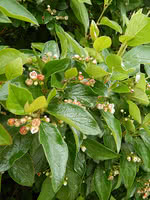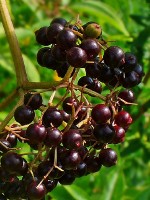Mon-Fri 9am - 5pm Mountain time
Shiny Cotoneaster (Hedge Cotoneaster) vs Ranch Elderberry
Cotoneaster lucidus
Sambucus canadensis Ranch
COMING SOON
(new stock expected: later this season)
NOT AVAILABLE THIS SEASON - MIGHT RETURN
The Shiny Cotoneaster (Hedge Cotoneaster) is a dense, deciduous shrub that gets its name from the glossy dark green leaves that turn an eye-catching mix of red and purple in the fall.
It produces small, pink flowers in spring and by late summer they are followed by red berries that ripen to black. This plant is great for attracting wildlife as it is loved by both birds and butterflies.
While the Shiny Cotoneaster does produce berries, they are inedible to humans. This plant takes pruning and shearing well, making it easy to shape to your liking and is a great choice for a hedge or privacy screen in your yard.
Ranch Elderberry is a vigorous and high-yielding Black Elderberry cultivar. It ripens earlier than other varieties and is smaller and more compact making berry harvest easier. The berries are well-suited for baked goods, jams, jellies, and syrups. They are high in vitamin C and reported to be beneficial for the immune system.
Black Elderberries are considered to be partially self-pollinating. So while they will still produce some berries without cross-pollination, planting with another variety will increase yields. Consider planting with Black Elderberry or Bob Gordon Elderberry.
Warning: the seeds, stems, leaves, roots, and uncooked berries are toxic to humans when eaten in quantity. Berries should be cooked to make them safe for human consumption.
Shiny Cotoneaster (Hedge Cotoneaster) Quick Facts
Ranch Elderberry Quick Facts
Toxicity: may cause stomach upset
Toxicity: leaves, stems, and uncooked berries are poisonous to humans

